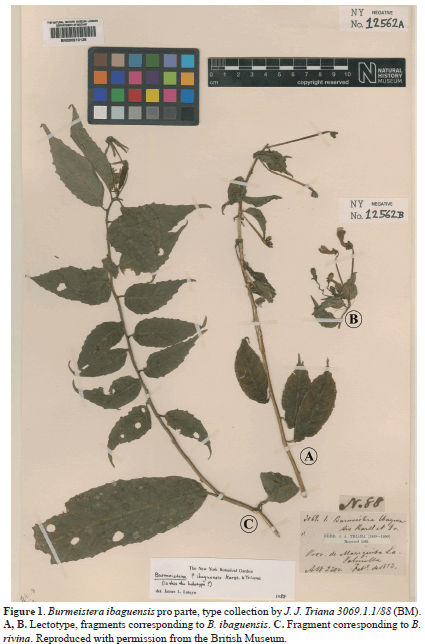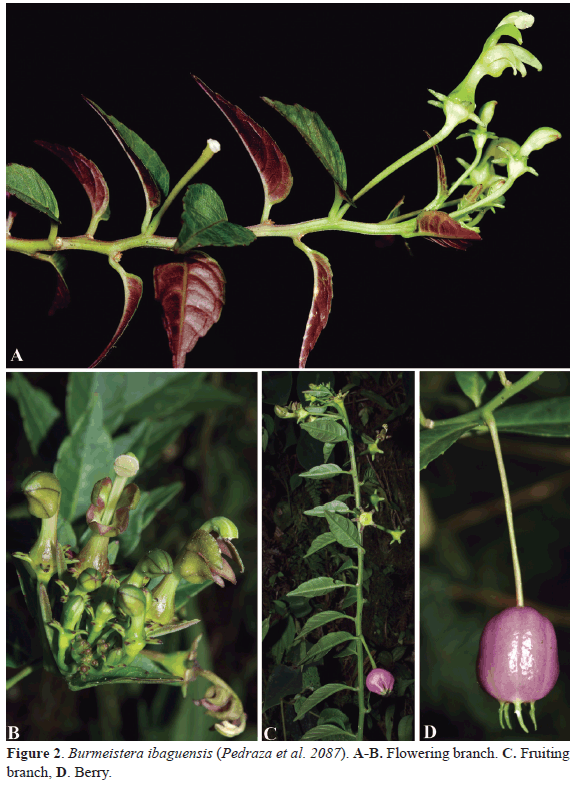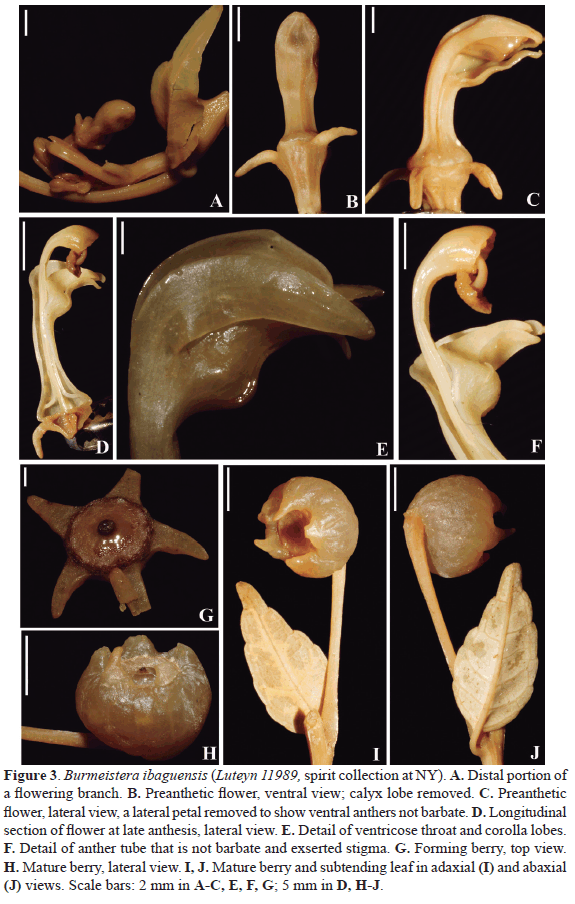Services on Demand
Journal
Article
Indicators
-
 Cited by SciELO
Cited by SciELO -
 Access statistics
Access statistics
Related links
-
 Cited by Google
Cited by Google -
 Similars in
SciELO
Similars in
SciELO -
 Similars in Google
Similars in Google
Share
Caldasia
Print version ISSN 0366-5232
Caldasia vol.37 no.2 Bogotá July/Dec. 2015
https://doi.org/10.15446/caldasia.v37n2.53595
FAVIO GONZÁLEZ
JAVIER GARZÓN VENEGAS
Universidad Nacional de Colombia, Facultad de Ciencias, Instituto de Ciencias Naturales, Apartado 7495, Bogotá. Autor correspondencia: fagonzalezg@unal.edu.co
ABSTRACT
The genus Burmeistera, described by J. J. Triana in 1854, was typified with the species B. ibaguensis. The type specimen of this species consists of three fragments, two of which correspond to the type species and the third fragment belongs to B. rivina. Here we clarify the typification of the genus and the two species mentioned, and revise the descriptions of these species. In addition, a lectotype is here designated for B. rivina, and the name B. ceratocarpa var. dentata is subordinated to synonymy.
Key words. Burmeistera, Campanulaceae, Lobelioideae, generic lectotypification, Neotropical flora.
RESUMEN
El género Burmeistera, descrito por J. J. Triana en 1854, fue tipificado con base en B. ibaguensis. El ejemplar tipo de esta especie consta de tres fragmentos, dos de los cuales corresponden a esta especie y un tercero a B. rivina. En el presente trabajo se aclara en detalle la tipificación del género y de las especies en mención, así como su redescripción. Adicionalmente, se lectotipifica la especie B. rivina, y se subordina el nombre B. ceratocarpa var. dentata a la sinonimia de esta especie.
Palabras clave. Burmeistera, Campanulaceae, Flora Neotrópica, Lobelioideae, lectotipificación genérica.
Recibido: 23/02/2015
Aceptado: 01/10/2015
INTRODUCTION
With approximately 110 species (Lammers 2007, Garzón& González 2014), Burmeistera Triana is the fourth largest genus of the subfamily Lobelioideae. Their species can be distinguished from those of their related genera Centropogon C. Presl. and Siphocampylus Pohl by the broad (versus narrow) apex of the anther tube, the fleshy, indehiscent fruits (versus capsules in most Siphocampylus spp.), and the fusiform (versus ellipsoid to oblate) seeds. The genus was described by the Colombian botanist José JerónimoTriana (1854), based on the species B. ibaguensis. Until now, the location of the type specimen and the identity of B. ibaguensis were in doubt, as it was stated in the following Editor's note by Tracy Elliot Hazen in Gleason's (1925:102) synopsis of the genus:
"In view of Dr. Gleason's characterization of G. (sic) lacerata as 'so common a plant,' it is a matter of surprise and disappointment to the editor, as a member of the Colombian Expedition of 1922, that this species was not found by us in the type region, the Quindio, where much time was spent in intensive collecting. It is even more disappointing that though two members of the Expedition, in going over the Old Quindio Trail to Ibagué, passed through "La Pamilla," (sic) the type station for Karstens unknown B. ibaguensis, no Burmeistera was found on that trip. This failure can hardly be ascribed entirely to the fact that this genus is characterized by inconspicuous green flowers".
The taxonomic uncertainty of Burmeistera ibaguensis was also recognized by Wimmer (1943:144), who included this species as one of the three poorly known species of Burmeistera ("Burmeisterae non satis notae"), all of which appear to be known to him only from the original descriptions.
During the ongoing taxonomic revision of Burmeistera for the Flora of Colombia, we have located the type specimen of B. ibaguensis, collected by Triana under the number 3069.1.1/88, and deposited in BM (Fig. 1). The label indicates that the specimen was collected in the "Prov. de Mariquita, La Palmilla, Alt. 2300 m, Febr. 1853," a locality that coincides the original description ("lugares sombríosdel Monte del Quindío, cerca de La Palmilla"; Triana 1854:14). A careful examination of the specimen reveals that it consists of three separate fragments, two of which (Fig. 1 A, B) match Triana's (1854) original description of B. ibaguensis, a species characterized, among other traits, by the leaf blades with glabrous lower surface, the hypanthium 3–4(–5) mm long, and the calyx lobes (2–)3–5 mm long, ascending to patent at right angle to hypanthium during anthesis, with entire margins. Only the smaller fragment (Fig. 1B) shows the dilated anther opening that distinguishes the genus Burmeistera. The third fragment (Fig. 1C) clearly differs in the leaf blades with puberulous lower surface, the hypanthium 6-8 mm long, and the calyx lobes > 1 cm long, strongly reflexed, with dentate margins. This third fragment clearly coincides to the protologue and the corresponding illustration of B. rivina (Wimmer 1943, Fig. 33:129), as well as the syntypes (Pennell 10421 and 10323) deposited in GH and NY, both examined by the authors. Additional characters that distinguish B. rivina from B. ibaguensis are the corolla tube 1.5–1.7 cm long and dorsal lobes 0.8–1 cm long; the filament tube puberulous, and the anther tube exserted 1.5–2 cm between the corolla dorsal lobes. The set of characters described above for B. rivina is diagnostic to species level throughout the genus Burmeistera (see e.g., Gleason 1925, Wimmer 1943, Wilbur 1976 a, b, Jeppesen 1981, Lammers 1998, Garzón-Venegas& González 2012, Garzón-Venegas et al. 2012, 2013). Thus, floral characters of B. rivina, especially the shape and orientation of calyx lobes and corolla, suggest close affinities to other species with long, strongly reflexed sepals, e.g. B. tenuiflora Donn. Sm., from Central America.

Burmeistera ibaguensis and B. rivina are partially sympatric in the Central Cordillera of Colombia (see below), and it is likely that the specimen was accidentally mixed either in the field or during the shipment and handling of Triana's collections from Bogotá, Colombia to Europe. Díaz-Piedrahíta (1999) described in detail this tortuous route, first to Paris, and then to London. The idiosyncratic method by which Triana numbered his collections could have added further confusion, as they consisted of a first number corresponding to Endlicher's (1841) generic numbers, followed by a personal collection number for each genus. Thus, all Burmeistera specimens collected by Triana bear the number 3069 (after the number given to Centropogon by Endlicher 1841:264), and this particular type specimen can be distinguished by the specimen number 3069.1.1/88. It corresponds to the BM catalogue number 1583.
Because we provide evidence that the type specimen associated with the name Burmeistera (Fig. 1) is mixed, we proceed to designate the fragments labeled as A and B in Fig. 1 as the lectotype of B. ibaguensis. This is in accordance to the Article 9.14 of the current International Code of Botanical Nomenclature (McNeill et al. 2012), which states that "(W)hen a type (herbarium sheet or equivalent preparation) contains parts belonging to more than one taxon, the name must remain attached to the part that corresponds most nearly with the original description or diagnosis." Additionally, revised descriptions of B. ibaguensis and B. rivina are provided.
Burmeistera ibaguensis Triana, Nuevos Jeneros y Espec. 13. 1854. TYPE: COLOMBIA Tolima/ Risaralda: "Prov. Mariquita, prope La Palmilla, alt. 2300 m, Feb 1853 (fl, fr), J. J. Triana 3069.1./88 p. p. (Lectotype BM, fragments A and B labeled on Fig. 1, here designated). Figs. 1A-B, Fig. 2, Fig. 3


Terrestrial herbs, occasionally climbers or hemi-epiphytes, profusely branched, branches often pendant, to 2 m in height, producing white latex. Stems moderately thick, terete to slightly winged distally, glabrous, green, often suffused with purple, internodes to 5 cm long. Leaves spirally arranged; petiole (1–)1.5–2.3 cm long, ca. 1 mm in diameter, green, often suffused with purple, glabrous; lamina ovate to elliptic, proximal laminas (8–)9–14(–17) x (2.5–)3.5–4.5(–6) cm, distal laminas (2.5–)3–6(–7) x 1–3 cm, membranous, sometimes slightly bullate, base frequently slightly asymmetric, obtuse to round, sometimes truncate, margins slightly sinuose-serrulate especially on the distal third of the lamina, with c. 30 teeth per side in the proximal leaves, and 7–12 teeth per side in the distal leaves, teeth in two size classes, the short ones interspersed with the long ones, obtuse, apex acute to shortly acuminate and often ending in a callose tooth, adaxial surface dark green, glabrous, abaxial surface green suffused with purple, glabrous, venation brochidodromous, prominent on the abaxial surface, (7–)9–11(–14) pairs of secondary veins in the proximal leaves and 5–10 pairs in the distal leaves, irregularly interspaced, higher order venation conspicuous, reticulate, submarginal vein present but interrupted. Flowers solitary, axillary to the distal leaves, often congested at the apex of the branches due to the shortened internodes between young leaves; peduncle 5–6 cm long, 1-2 mm in diameter, ascending, green and often suffused with maroon, glabrous, ebracteate. Hypanthium obconic to subglobose, 3–4(–5) x 3–5(–7) mm, green and often suffused with maroon, glabrous, with 10 conspicuous longitudinal veins; calyx lobes linear to narrowly ovate, (2–)3–5 mm x 0.5–1.5 mm, glabrous, ascending to patent at right angle with respect to the hypanthium during anthesis, secondary veins inconspicuous, margins entire, apex acute, interlobular sinuses 1-4 mm wide; corolla nearly straight during anthesis, 1.5–2.2 cm long, glabrous outside, green to green and pale yellow, often suffused with maroon especially around the base, green inside, tube straight, 9–14 x 2–3 mm at its midpoint, base and throat ventricose, lobes erect, with acute apices, slightly unequal in size, dorsal lobes oblong-triangular, falcate, 10–15 x 3–5 mm, lateral lobes oblong-triangular, falcate, 5–7 x 2–3 mm, ventral lobe ovate, deflexed, 4–5 x 4 mm; filament tube 2–2.5 cm long, glabrous, anther tube obconic, 4–5 mm long and 4 mm in distal diameter, exserted 10–15 mm between the corolla dorsal lobes, dorsal and lateral anthers 4–5 mm long, the two ventral anthers 3–4 mm long, glabrous; stigma bilobed, discoidal during post-anthesis and exserted 3–4 mm from the anther tube. Berries subglobose to ovoid, 0.8–1 cm diam., fleshy, not inflated, green to green and pale yellow when immature, pink to magenta at maturity, glabrous outside, crowned by the persistent, erect calyx lobes; seeds fusiform, ovoid, to 1.3 x 0.4 mm.
Distribution and habitat. Burmeistera ibaguensis is restricted to the Western and the Central cordilleras of Colombia. It grows in the understory of cloud belts of wet montane forests between 1200 and 3100 m in elevation, in the departments of Antioquia, Risaralda, Tolima and probably Quindío. It has been collected with flowers and fruits between January and July, and between September and November.
Additional specimens examined: COLOMBIA. Antioquia: Caramanta, vereda Barroblanco, 5-10 km de Caramanta a Rioblanco, Cordillera Central, 5°34.8'N, 75°40.54'W, 2350–2410 m, 14 Oct 1988 (fl), J. Betancur et al. 1019, 1021 (HUA); Urrao, corregimiento de Encarnación, Parque Nacional Natural Las Orquídeas, camino entre Encarnación y sector Calles, cerca de la quebrada San Pedro, 1700 m, 6 Abr 2011 (fl, fr), J. Betancur et al. 15024 (COL, MEDEL); Urrao, sitio el Páramo, entre Encarnación y sector Calles, 1800–2200 m, 15 Abr 2011 (fl, fr), J. Betancur et al. 15240 (COL, MEDEL), Frontino, road to Murrí, 15 km W of Nutibara, Alto de Cuevas, ca. 1 km S of road, 6°45'N, 76°23'W, 1850 m, 17 Oct 1987 (fl), A. E. Brant & G. E. Martínez 1343 (HUA); Frontino, road to Murrí, 15 km W of Nutibara, Alto de Cuevas, margin of primary forest ca. 1 km S of road, 6°45'N, 76°23'W, 1850 m, 17 Oct 1987 (fl), A. E. Brant & G. E. Martínez 1344 (HUA, MO); Frontino, corregimiento La Blanquita, región de Murrí, Alto de Cuevas, 14.5 km W de Nutibara en la vía a La Blanquita, 6°45'N, 76°25'O, 1850 m, 14 Jul 1988 (fl, fr), R. Callejas et al. 6819 (NY); Frontino, corregimiento La Blanquita, Región de Murrí, Alto de Cuevas, 14.5 km W de Nutibara en la vía a La Blanquita, 6°45'N, 76°25'O, 1850 m, 14 Jul 1988 (fl, fr), R. Callejas et al. 6838 (HUA, NY); Jericó, 3 km O en la vía Jericó-Pueblo Rico, bosques en la margen de quebrada La Leona, 5°50'N, 75°45'W, 1890–2050 m, 29 Sep 1989 (fl, fr), R. Callejas et al. 8427 (HUA, NY); Támesis, vereda Río Frío, 2100 m, 09 Nov 1989 (fl, fr), R. Fonnegra et al. 3224 (COL, HUA); Abriaquí, Parque Nacional Las Orquídeas, vereda Piedras, sitio La Linda ("La Truchera"), 6°38'13.6"N, 76°8'0.4"W, 2500 m, 01 Feb 2012 (fl, fr), M. F. González et al. 730, 755, 762 (COL); Urrao, páramo de Frontino, El Río, 3040 m, 08 Ene 1984, R. Londoño et al. 164 (NY); Frontino, corregimiento Nutibara, region of Murrí, Alto de Cuevas, ca. 6°45'N, 76°20'W, 1500–1880 m, 16-18 Oct 1987 (fl), J. L. Luteyn et al. 11699 (HUA, NY); Frontino, corregimiento Nutibara, region of Murrí, Altos de Cuevas, ca. 6°45'N, 76°20'W, 1500–1880 m, 16-18 Oct 1987 (fl, fr), J. L. Luteyn et al. 11708 (NY); Frontino, corregimiento Nutibara, Nutibara-La Blanquita rd., region of Murrí, Alto de Río Cuevas, ca. 6°45'N, 76°20'W, 1700–1800 m, 19 Abr 1988 (fl), J. L. Luteyn et al. 11989 (NY, PSO); Frontino, corregimiento Nutibara, Nutibara-La Blanquita Rd, region of Murrí, Alto de Río Cuevas, ca. 9–18 km W of Nutibara, ca. 6°45'N, 76°20'W, 1450–2130 m, 6-10 Apr 1989 (fl), J. L. Luteyn & D. S. Sylva 12454 (COL, HUA, NY); Jardín, vereda Ventanas, Jardín-Ventanas-Riosucio road, 12–19 km SSE of Jardín, 5°40'N, 75°47'W, 2320–2800 m, 3 May 1989 (fl, fr), J. L. Luteyn & O. Escobar 12727 (HUA, NY); Urrao, between Páramo de Frontino and finca La Granada below El Quince, 6°25'N, 76°05' W, 2500–3500 m, 4 Mar 1989 (fl), J. M. MacDougal et al. 4581 (HUA, NY); Urrao, on trail to finca La Quince, above Urrao, 6°30'N, 76°10'W, 2500–2800 m, 21 Nov 1988 (fl, fr), G. McPherson et al. 13232 (COL, HUA, NY); Frontino, region of Murrí, c. 13 road-km from Nutibara, 6°40'N, 76°20'W, 2000 m, 9 Dic 1988 (fl, fr), G. McPherson et al. 13399 (HUA, NY); Urrao, camino de herradura hacia Abriaquí, a orillas del río de la Mina, 2650 m, 7 Dic 1984 (fl), C. I. Orozco et al. 1416 (COL); Urrao, corregimiento Encarnación, vereda Calles, Parque Nacional Natural Las Orquídeas, camino Calles-La Encarnación, después de la confluencia del río Polo y el río Calle y antes del río San Pedro, sitio La Quiebra, 6°30'31"N, 76°14´W, 1600–1850 m, 31 Ene-2 Feb 2011 (fl, fr), P. Pedraza et al. 2087 (COL, NY); Frontino, corregimiento Nutibara, cuenca alta del río Cuevas, 17 Mar 1984 (fl, fr), D. Sánchez et al. 108 (NY); Frontino, corregimiento Nutibara, cuenca alta del río Cuevas, 1780 m, 23 Sep 1987 (fr), D. Sánchez et al. 1563 (HUA); Yarumal, quebrada 19 km N of Yarumal along Medellín-Cartagena Hwy. c. 2 km S of Alto de Ventanas, 7°04'N, 75°27'W, 2000 m, 7 Feb 1986 (fl, fr), B. A. Stein & A. Cogollo 3367 (COL); Frontino, km 15.5 of road Nutibara-Murrí, 06°45'N, 76°23'W, 1830 m, 22 Sep 1987 (fl), J. L. Zarucchi et al. 5621 (HUA); Frontino, km 17 of road Nutibara-Murrí, 06°45'N, 76°23'W, 1650 m, 22 Sep 1987 (fl, fr), J. L. Zarucchi et al. 5643 (HUA); Frontino, km 17 of road Nutibara-La Blanquita, region of Murrí, steep slope opposite roadway, 6°45'N, 76°24'W, 1860 m, 3 Nov 1988 (fl, fr), J. L. Zarucchi et al. 7072, 7101 (COL, HUA). Risaralda: Rio San Rafael, Cerro Tatamá, 2500-2800 m, 7-11 Sep 1922 (fl), F. W. Pennell 10323 (NY). Tolima: East slopes of Cordillera Central, Río Combeima valley, road from Ibagué toward Nevado del Tolima, 11 km above Juntas, finca El Silencio, ca. 4°37´N, 75°20'W, 2500 m, 20 Feb 1986 (fl), B. A. Stein 3523 (COL).
Burmeistera rivina E. Wimm., Repert. Spec. Nov. Regni Veg. 38: 4. 1935. Syntypes: Colombia. Risaralda: "Rio San Rafael, below Cerro Tatama, clearing, 2200–2400 m, 7-11 Sep 1922 (fl), F. W. Pennell 10323 (NY); "Rio San Rafael in silva infra Cerro Tatama, along streams in forest, 2500-2800 m", 7-11 Sep 1922 (fl, fr), F. W. Pennell 10421 (NY). Lectotype, here designated: Colombia. Risaralda: Rio San Rafael, Cerro Tatamá, 2500-2800 m, 07-11 Sep 1922 (fl), F. W. Pennell 10421 (NY; isolectotype GH). Fig. 1C, Fig. 4

B. ceratocarpa Zahlbr. var. dentata E.Wimm., Pflanzenr. IV.276b: 154. 1943. Tipo. Colombia. Risaralda: Rio San Rafael, Cerro Tatamá, 2500–2800 m, 7-11 Sep 1922 (fl), F. W. Pennell 10421 (holotype NY). Syn. nov.
Terrestrial herbs to 1.2 m in height. Stems slender terete, glabrous, fistulose, green suffused with maroon, producing white latex, internodes 2-4 cm long, producing white latex. Leaves distichous; petiole 1–1.7 cm long, glabrous; lamina ovate to elliptic, rarely oblong, proximal laminas 7–9(–12) x 3–4(–5) cm, distal laminas 3-5 x 1.5-3 cm, base nearly round, truncate or slightly cuneate, margins with short and triangular teeth, each ending in a callose papilla, apex acuminate to cuspidate, green and often suffused with purple and slightly puberulous on the abaxial surface, venation brochidodromous, secondary veins 6-8 pairs, ascending in ca. 45° angles with respect to the midvein. Flowers solitary, axillary to the distal leaves; peduncle 4.5–5.5 cm long, glabrous, ebracteate. Hypanthium subglobose, 6–8 mm long; calyx lobes narrowly oblong, 10–14 x 1–3 mm, strongly reflexed, margins slightly dentate, apex obtuse and often ending in a callose tooth; corolla slightly curved during anthesis, 1.6–2 cm long, glabrous outside, green or green and yellow, tube 15–17 x ca. 3 mm long, in diam. at its midpoint, base and throat ventricose, lobes ovate-falcate, unequal in size, dorsal lobes 8–10 x 3–4.5 mm, lateral lobes 5-6 x 2-3 mm, ventral lobe ovate, 4–5 x 3–3.5 mm; filament tube to 2 cm long, puberulous, anther tube narrowly obconic, 4.5–6 mm long and 3 mm in distal diam., exserted 1.5–2 cm between the corolla dorsal lobes, uniformly shortly villous at opening, dorsal and lateral anthers 5–6 mm long, ventral anthers not barbate. Berries globose, ca. 1 cm diam, fleshy, not inflated, purple, crowned by strongly reflexed calyx lobes; seeds fusiform, ovoid, to 1.2 x 0.4 mm.
Distribution and habitat. Burmeistera rivina is restricted to the Western and the Central cordilleras of Colombia. It grows in Subandean and Andean wet montane forests of the departments of Chocó, Risaralda, and probably Quindío, at elevations between 900 and 2800 m. It has been collected with flowers and fruit in January, March through June, and September.
The examination of the type specimens and the original description of Burmeistera ceratocarpa Zahlbr. var. dentata shows no differences with B. rivina. Thus, we subordinate here this infraspecific name to the synonymy of the latter.
Additional specimens examined: COLOMBIA. Chocó: Mountain ridge above (W of) El Carmen de Atrato, dividing Río Atrato and Río Habito valleys, c. 5°54´N, 76°09´W, 2200–2400 m, 30 Jan 1986 (fl, fr), B. A. Stein & L. McDade 3317 (NY). Quindío: "Palmilla" Triana 3069.1/88 p. p. (BM). Risaralda: Pereira, Parque Regional Ucumarí, entre El Cedral y La Pastora, 2300 m, 14 Jun 1989 (fl, fr), R. Bernal et al. 1640 (COL); Mistrató, corregimiento Jeguadas, entre Puerto de Oro y Jeguadas, 900-1400 m, 19–21 Sep1991 (fl, fr), J. Betancur et al. 2816 (COL); Mistrató, corregimiento de Jeguadas, 5°26' N, 76°02' W, 28 Mar–2 Abr 1992 (fl), J. Betancur et al. 3161 (COL); Mistrató, corregimiento de Puerto de Oro, vía Pisones-Jeguadas, Río Mistrató, 1400–1800 m, 20 Sep 1991 (fl), J. L. Fernández et al. 9115 (COL); Pereira, Parque Natural Regional Ucumarí, 1850–2460 m, 11 Jun 1989 (fl, fr), F. González et al. 1537 (COL); Pereira, Parque Regional Ucumarí, ca. 22 km ESE of Pereira, 2100–2670 m, trail to Ucumarí, through Ceiba forest at lowest elevation to cloud forest at upper, ca. 4°40'N, 75°35'W, 25 May 1989 (fl, fr), J. L. Luteyn & O. Rangel 13106 (NY); Pereira, Parque Regional Ucumarí, 2300 m, 25 May 1994 (fl, fr), C. Murcia UMK-181 (HUA); Marsella, corregimiento La Nona, Convención, Reserva La Nona, 1700–2000 m, 12-17 Mar 1999 (fl, fr), W. Vargas 5654 (HUA).
ACKNOWLEDGEMENTS
We thank the curators of the herbaria BM, GH, HUA, MEDEL, NY and PSO for making the specimens for this study accessible. The curatorial staff of the Natural History Museum, London granted permission to publish the scanned digital image of the type of Burmeistera. We also thank the Fundación para la Promoción de la Investigación y la Tecnología, Banco de la República, and the Dirección Nacional de Investigaciones, de la Universidad Nacional de Colombia, for funding the projects 2413/2009 and 201010011272, respectively. Thanks also to J. Betancur (Institute of Natural Sciences, National University of Colombia) and his research team for providing the photographs of Fig. 2, and to N. Pabón-Mora (Universidad de Antioquia) for editing the figures. Finally, we acknowledge three anonymous reviewers, who made important comments and suggestions.
LITERATURE CITED
1. Díaz-Piedrahíta, S. 1999. José Jerónimo Triana. El Caballero de las Flores. Colciencias, Bogotá, 76 pp. [ Links ]
2. Endlicher, S.F.L. 1841. Enchiridion Botanicum, exhibens classes et ordines plantarum accredit nomenclator generum et officinalium vel usualium indication. Leipzig, Sumptibus G. Engelmann, 763 pp. [ Links ]
3. Garzón-Venegas, J. & F. González. 2012. Five new species and three new records of Burmeistera (Campanulaceae, Lobelioideae) from Colombia. Caldasia 34:309-324. [ Links ]
4. Garzón-Venegas, J. & F. González. 2014. Burmeistera diazii (Campanulaceae, Lobelioideae), una especie nueva de los Andes de Antioquia, y notas acerca del nuevo registro de B. loejtnantii para Colombia. Caldasia 36: 253-260. [ Links ]
5. Garzón-Venegas, J., F. González & J. M. Vélez-Puerta. 2012. Burmeistera minutiflora (Campanulaceae–Lobelioideae), a new species from the high Andes of Antioquia (Colombia) with the smallest flowers on the genus. Anales del Jardín Botánico de Madrid 69: 243-246. [ Links ]
6. Garzón-Venegas, J., J.M. Vélez Puerta & F. González. 2013. Three new species of Burmeistera (Campanulaceae-Lobelioideae) from Colombia. Brittonia 65:119-127. [ Links ]
7. Gleason, H.A. 1925. Studies on the flora of northern South America–IV: The genus Burmeistera. Bulletin of the Torrey Botanical Club 52: 93–104. [ Links ]
8. Jeppesen, S. 1981. Lobeliaceae. In: G. Harling & B. Sparre (eds.), Flora of Ecuador 14: 9–170. Swedish Natural Science Research Council. Stockholm. [ Links ]
9. Lammers, T. G. 1998. Review of the neotropical endemics Burmeistera, Centropogon, and Siphocampylus (Campanulaceae: Lobelioideae), with description of 18 new species and a new section. Brittonia 50: 233-262. [ Links ]
10. Lammers, T.G. 2007. World checklist and bibliography of Campanulaceae. Royal Botanic Gardens, Kew, U.K. [ Links ]
11. McNeill, J., F.R. Barrie, W.R. Buck, V. Demoulin, W. Greuter, D.L. Hawksworth, P.S. Herendeen, S. Knapp, K. Marhold, J. Prado, W.F. Prud'Homme van Reine, G.F. Smith & J.H. Wiersema (eds.). 2012. International Code of Nomenclature for algae, fungi, and plants (Melbourne Code). Regnum Vegetabile 154. Koeltz Scientific Books. [ Links ]
12. Triana, J.J. 1854. Nuevos jeneros i especies de plantas para la flora neo-granadina. Imprenta del Neo-Granadino. Bogotá [ Links ].
13. Wilbur, R.L. 1976a. A synopsis of the Costa Rican species of Burmeistera (Campanulaceae: Lobelioideae). Bulletin of the Torrey Botanical Club 102: 225–231. [ Links ]
14. Wilbur, R.L. 1976b. Campanulaceae. In: R. E. Woodson Jr. & R. W. Schery (eds.), Flora of Panama: part IX. Family 183. Annals of the Missouri Botanical Garden 63: 593-655. [ Links ]
15. Wimmer, F.E. 1943. Campanulaceae–Lobelioideae I. In: R. Mansfeld (ed.). Das Pflanzenreich IV (276b): i–viii, 1–260. W. Engelman, Berlin. [ Links ]













